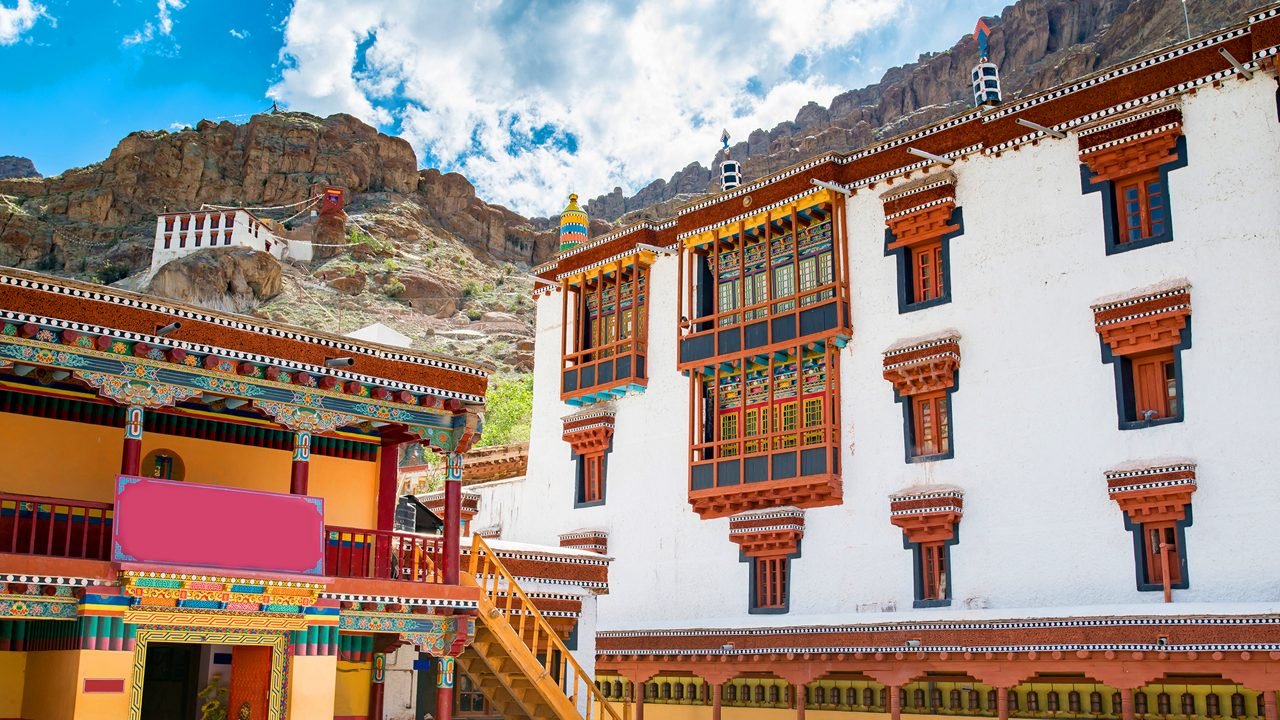Introduction
Nestled in the rugged mountains of Ladakh, Hemis Monastery stands as a testament to centuries of Buddhist tradition and Himalayan resilience. This sacred site, perched at an elevation of approximately 12,000 feet, offers more than just breathtaking views it provides a deep dive into the rich tapestry of Tibetan Buddhism and Ladakhi culture.
A Glimpse into Hemis Monastery’s Origins
The history of Hemis Monastery is both ancient and revered. While its exact founding date remains a topic of scholarly debate, it’s widely accepted that the monastery was re-established in the 17th century by King Sengge Namgyal. Under his patronage, the monastery flourished, becoming a prominent center for the Drukpa Kagyu lineage of Tibetan Buddhism. This lineage emphasizes spiritual practice and meditation, drawing followers from across the region.
Architectural Marvels Amidst the Himalayas
Hemis Monastery’s architecture is a harmonious blend of Tibetan and Ladakhi styles. Constructed with whitewashed walls and adorned with intricate murals, the monastery’s design reflects the region’s Buddhist heritage. The layout includes prayer halls, courtyards, and living quarters for monks, all meticulously planned to adapt to the challenging high-altitude environment. The elevated position not only offers panoramic views of the Indus Valley but also aligns with Buddhist principles of building sacred sites on high ground for spiritual elevation.
The Hemis Festival: A Celebration of Faith
One of the most anticipated events at Hemis Monastery is the annual Hemis Festival, held in early June. This vibrant celebration honors Guru Padmasambhava, the 8th-century Indian master credited with establishing Buddhism in Tibet. The festival features traditional Cham dances performed by monks in elaborate costumes, accompanied by rhythmic drumbeats and cymbals. These dances are believed to ward off evil spirits and bring blessings to the community. The Hemis Festival not only showcases spiritual devotion but also offers visitors a glimpse into the rich cultural tapestry of Ladakh.
Hemis Monastery’s Role in Tibetan Buddhism
Beyond its architectural and cultural significance, Hemis Monastery plays a pivotal role in the spiritual life of the region. As the principal seat of the Drukpa Kagyu lineage, it serves as a center for meditation, study, and monastic education. The monastery houses a vast collection of sacred texts, thangkas (religious paintings), and statues, preserving the teachings and traditions of Tibetan Buddhism for future generations.
Visiting Hemis: A Journey to the Sacred
For travelers seeking a blend of adventure and spirituality, a visit to Hemis Monastery is a must. Located approximately 45 kilometers from Leh, the journey to the monastery offers stunning views of the Ladakhi landscape. The best time to visit is during the summer months, from May to September, when the weather is conducive for travel and the monastery is accessible. Visitors can explore the monastery’s serene surroundings, participate in meditation sessions, and witness the vibrant festivities during the Hemis Festival.
Hemis Monastery and Its Connection to Nature
Situated in the vicinity of Hemis National Park, the monastery is surrounded by pristine natural beauty. The park is renowned for its diverse flora and fauna, including the elusive snow leopard. This proximity underscores the harmonious relationship between the monastic community and the natural world, reflecting the Buddhist principle of living in harmony with all beings.
Preserving the Legacy of Hemis Monastery
In recent years, efforts have been made to preserve and protect Hemis Monastery’s cultural and spiritual heritage. Restoration projects aim to maintain the integrity of its structures and artifacts, ensuring that future generations can experience and learn from this sacred site. These initiatives highlight the importance of safeguarding cultural landmarks in the face of modernization and environmental challenges.
The Spiritual Significance of Hemis Monastery
For many, Hemis Monastery is more than just a tourist destination; it is a place of deep spiritual significance. Pilgrims visit the monastery to seek blessings, engage in meditation, and connect with the divine. The tranquil environment and sacred rituals provide a sanctuary for introspection and spiritual growth.
Engaging with the Local Community
A visit to Hemis Monastery also offers an opportunity to engage with the local Ladakhi community. The people of Ladakh are known for their warmth and hospitality. Visitors can learn about traditional Ladakhi culture, participate in community events, and support local artisans by purchasing handmade crafts. This cultural exchange enriches the travel experience and fosters mutual understanding.
Conclusion: Hemis Monastery as a Timeless Beacon
Hemis Monastery stands as a timeless beacon of Tibetan Buddhism, offering a unique blend of spiritual depth, cultural richness, and natural beauty. Its enduring legacy continues to inspire pilgrims, scholars, and travelers alike. Whether you’re seeking spiritual enlightenment, cultural immersion, or simply a peaceful retreat, Hemis Monastery offers a sanctuary where the past and present converge in harmony.
FAQs About Hemis Monastery
1. What is the best time to visit Hemis Monastery?
The optimal time to visit is during the summer months, from May to September, when the weather is favorable and the monastery is accessible.
2. How far is Hemis Monastery from Leh?
Hemis Monastery is located approximately 45 kilometers southeast of Leh, making it a convenient day trip for travelers.
3. What is the Hemis Festival?
The Hemis Festival is an annual celebration held in early June to honor Guru Padmasambhava. It features traditional Cham dances, music, and rituals that attract visitors from around the world.
4. Can visitors participate in meditation at the monastery?
Yes, visitors are welcome to participate in meditation sessions and experience the serene environment of the monastery.
5. Is Hemis Monastery accessible by public transport?
While public transport options are limited, visitors can hire taxis or join guided tours from Leh to reach the monastery.
6. Are there accommodations near Hemis Monastery?
Yes, there are several guesthouses and homestays in the vicinity of Hemis Monastery that offer comfortable accommodations for travelers.
